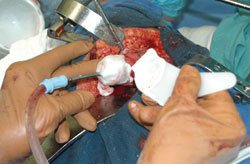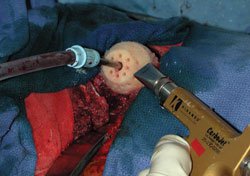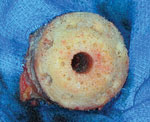Training and experience seen as key to lower hip resurfacing complication rates
Surgeons believe training should review soft tissue exposure, instrumentation and best practices.
Although two hip resurfacing arthroplasty prostheses are FDA-approved and others are in the regulatory pipeline, there is limited experience with the procedure. This has raised the level of importance of orthopedists fully understanding proper indications for metal-on-metal hip resurfacing.
Manufacturers are also proceeding cautiously when rolling out resurfacing products by limiting their use to surgeons who have completed the required training. Their goals include tracking early results and training surgeons in skills critical to overcoming the intricate aspects of these more difficult hip arthroplasty cases.
“We want to shorten the learning curve by providing the surgeons at our training courses with whatever they need to know to ensure they do it right the first time,” said Richard A. Conn, MD, an instructor for the Cormet Hip Resurfacing System [Corin] training program run by Stryker.
The first users of the FDA-approved Birmingham hip resurfacing system [Smith & Nephew] in the United States succeeded in keeping complication rates within the range of other large series, according to Craig J. Della Valle, MD. “This is probably due to prior work on indications and the Smith & Nephew training program, which got that information and other potential pitfalls across,” he told Orthopedics Today.
Product training
“The key we try to emphasize, as far as … adopting this technology, is getting the training,” Conn said. The Cormet system 1-day course covers selecting well-indicated patients and provides hands-on use of instrumentation so surgeons can appreciate how that helps them with the exposure and implantation steps, he said.
|
|
Images: Amstutz HC |
Conn and Della Valle noted that proper training and increasing experience can help total joint specialists who perform hip resurfacing arthroplasty avoid the procedure’s classic pitfalls of femoral neck fractures, poor patient choice and suboptimal implant positioning, including centering and seating.
They were among surgeons familiar with the three main models of implants used in this country — the FDA-approved Birmingham hip resurfacing system and Cormet hip resurfacing system and the not FDA-approved Conserve-Plus hip resurfacing system [Wright Medical Technology Inc.] — who spoke with Orthopedics Today on the benefits of a sanctioned training program and how obtaining greater resurfacing arthroplasty experience may contribute to better overall results.
Hip experience
An analysis of initial Birmingham hip resurfacing cases performed by seven hip specialists at five U.S. centers Robert L. Barrack MD, presented to the Hip Society Summer 2008 Meeting, found a complication rate approximately two to four times lower than noted in other published series, including a published study of the first 500 Birmingham hip resurfacings implanted in the United States.
There were three fractures among the group’s 650 cases. “That is a fracture rate of 0.5%,” Barrack said, which is “much lower than any of the national registries.”
Barrack noted hip reconstruction specialists using the same prosthesis and implantation technique and who participated in the same training program had these results.
“There is a range of literature that shows quite a volume effect in many procedures, particularly hip and knee implant procedures,” he said. “If anything, this is magnified in hip resurfacing.”
Research by Harlan C. Amstutz, MD, and colleagues supported the value of using a proven and reproducible surgical technique. Amstutz designed the Conserve-Plus prosthesis.
In studying 926 hip resurfacings for more than 10 years, researchers found an improved surgical technique contributed to better initial fixation and significant reduction of femoral loosening, leading to improved mid-term durability of the Conserve-Plus prosthesis.
“These technical improvements were developed based on information from implant retrievals and aim for better cleansing and drying during implantation of the prosthesis as well as maximizing the area of fixation between bone and cement,” Amstutz told Orthopedics Today.
|
Image: Della Valle CJ |
Amstutz has amassed extensive experience with the Conserve-Plus system. Though not FDA-approved, it is cleared for use outside the United States. Those who plan to do the procedure on individuals on the fringes of proven indications should review the technique and results, he said.
Good position
These surgeons feel femoral neck fractures are highly avoidable by adhering to proper patient selection and femoral bone preparation to optimize fixation.
“It is a challenge to consistently get these parts positioned properly. We may ultimately evolve into 3-D technologies such as navigation and CT-based guidance to get the variation in position down,” Bernard N. Stulberg, MD, whom uses and trains others on the Cormet resurfacing system.
Each surgeon’s personal learning curve depends on their previous hip arthroplasty experience and other factors. “The three major areas that require focus are the soft tissue exposure, instrumentation and the best technique practices for seating components properly. Our job is to make sure they understand how to apply the instrumentation safely,” Stulberg said.
Indications
Age and gender are patient selection criteria that must be respected with resurfacing arthroplasty procedure, Stulberg added. “My indications have been relatively narrowed to the male patient and those in the under-55, even under-50 age category,” he said.
Stulberg and Conn perform hip resurfacings in women beyond childbearing age, but review the risks with these patients beforehand and encourage them to get a DXA scan.
Choosing properly sized components, particularly on the femoral side, to enhance surface area contact with bone is another critical factor, they said.
“Some manufacturers are concerned about the use of smaller-sized components,” Stulberg told Orthopedics Today. “The Stryker training program urges caution in the use of sizes less than 44 mm as the data from the Cormet IDE suggested increased failure rates in patients with small femoral components.”
Stryker is currently compiling a registry of Cormet hip resurfacing cases in patients implanted following the device’s approval and the introduction of the training program to study the initial results of the training effort. Corin continues to prospectively collect and analyze data from the Cormet IDE (investigational device exemption) trial and to continue post-market surveillance as required. Stulberg, who is working on the registry with other Cormet users, said findings from the initial group’s 5- to 6-year follow-up are not yet ready for release.
“The data suggested that as [surgeons] did more [procedures], they got better,” he said, explaining that new surgical tricks and patient-selection information from the follow-up are being provided to surgeons enrolled in the Corin/Stryker training program to aid their progress.
Amstutz emphasized that he has learned through his 12-year experience with hip resurfacing that the most important risk factors are, “those patients who have low body mass indexes, most having small component size — which is not based on gender, so both males and females with a small fixation area must have an optimized technique.”
For more information:References:
- Harlan C. Amstutz, MD, can be reached at Joint Replacement Institute, 2400 S. Flower St., Los Angeles, CA 90007; 213-742-1075; e-mail: harlanamstutz@dochs.org. He receives research support from and is a consultant to Wright Medical Technology Inc.
- Robert L. Barrack, MD, can be reached at Washington University Medical Center, 660 S. Euclid, Campus Box 8233, Dept. of Orthopedics, St. Louis, MO 63110; 314-747-2592; e-mail: barrackr@wustl.edu. He receives research funding and royalties from Smith & Nephew Orthopaedics and he receives research funding from Zimmer, Wright Medical Technology Inc., and Medtronic.
- Richard A. Conn, MD, can be reached at Southern Bone and Joint Specialists, 3688 Veterans Memorial Drive, Suite 200, Hattiesburg, MS 39401; 601-554-7402; e-mail: theicon@netdoor.com. He is a consultant to Stryker Orthopaedics for hip resurfacing training labs.
- Craig J. Della Valle, MD, can be reached in the Department of Orthopaedic Surgery, Rush University Medical Center, 1725 West Harrison, Suite 1063, Chicago, IL 60612; 312-432-2350; e-mail: craigdv@yahoo.com. He has received paid travel from Smith & Nephew and Stryker.
- Bernard N. Stulberg, MD, can be reached at Cleveland Clinic Center for Adult Reconstruction at Lutheran, 1730 W 25th St., Cleveland, OH 44113; 216-363-3300; e-mail: stulbeb@ccf.org. He is a consultant to Stryker.
- Amstutz HC, LeDuff MJ, Campbell PA. 10 years of experience with metal-on-metal hybrid hip resurfacing: A review of 1000 hips. #46. Presented at the American Academy of Orthopaedic Surgeons 75th Annual Meeting. March 5-9, 2008. San Francisco.
- Barrack RL, Brooks PJ, Engh CA, et al. The learning curve for adopting hip resurfacing among hip specialists. Presented at The Hip Society Summer Meeting. Sept. 25-27, 2008. Chicago.
- Della Valle CJ, Nunley RM, Raterman SJ, Barrack RL. Initial American experience with hip resurfacing following FDA approval. Clin Orthop Relat Res. 2009;467(1):72-78.
- Stulberg BN, Trier KK, Naughton M, Zadzilka JD. Results and lessons learned from a United States hip resurfacing investigational device exemption trial. J Bone Joint Surg (Am). 2008; 90(Suppl) 3:21-26.



